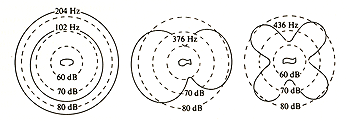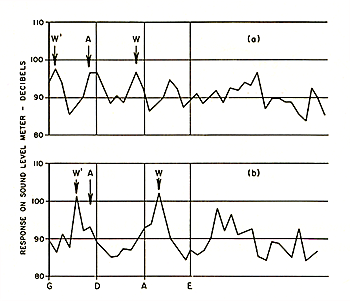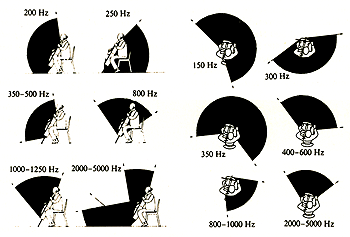Home | Audio | DIY | Guitar | iPods | Music | Brain/Problem Solving | Links| Site Map
This work is licensed under a Creative Commons License.
Resonance and Radiation of Acoustic Instruments
By Scott Wilkinson, Electronic Musician
A little physics goes a long way in the recording studio.
This article originally appeared in the September 1994 issue of Electronic Musician.
Recording engineers wear many hats. To capture the best possible sound, they must be competent in operating all the studio gear (which, taken together, resembles the flight deck of jumbo jet), be able to solve any musical problems, and coddle the artists into giving their best performances.
An understanding of physics doesn't hurt, either. For example, if an engineer knows something about the sound radiation patterns of acoustic instruments, he or she can position the microphone for optimum audio reproduction. Most engineers learn about mic placement through experience, but a little quantitative knowledge can help a great deal.
Another area of concern is the resonant characteristics of acoustic instruments. Many instruments do not emit sound at a uniform volume, even when the player maintains a consistent dynamic level. Certain notes sound louder than others because of the resonances within the instrument. However, most engineers don't know the specifics of these resonances, relying solely on their ears and experience to reveal appropriate mic placement and EQ settings.
Experience is a great teacher, but a little knowledge about sound radiation and resonance can help pave the path of experience, making it easier to attain the status of "golden ears."

FIG 1: Sound radiation patterns at four resonant frequencies of a Martin D-28 folk guitar. In all three patterns, the sound hole is pointing downward. (From "Sound Radiation from Classical and Folk Guitars," by J. Popp and T.D. Rossing.
GUITAR
Like all string instruments, the acoustic guitar consists of a body, neck, and tensioned strings. Plucking the strings produces sound, but very little of this sound actually comes from the strings themselves. Instead, the vibrating strings transfer energy to the bridge and top plate of the guitar body, which in turn excites the air cavity within the instrument (as well as the sides and back). Most of the sound is radiated by the vibrating body and air moving through the sound hole.
Any enclosed space exhibits resonance, which is the tendency to vibrate easily at certain frequencies, and the guitar body and air cavity are no exceptions. Most acoustic guitars have three strong resonances in the 100 Hz to 200 Hz range. The lowest resonance results from the soundboard (top) and back plate (bottom) vibrating in opposite directions, causing the guitar to "breathe" air in and out of the sound hole. On a Martin D-28 used in experimental measurements, this resonance occurs at 102 Hz.
The other two resonances occur slightly above and below 200 Hz. On the D-28, the resonance at 193 Hz results from the soundboard and back plate vibrating in the same direction, while the resonance at 204 Hz occurs as they vibrate in opposite directions.
Higher resonances occur as the soundboard and back plate vibrate in more complicated patterns. For example, they can vibrate in halves—that is, when the right half is bending outward, the left half is bending inward. This way, the soundboard and back plate can vibrate in-phase or out-of-phase with each other, resulting in a resonance around 300 Hz in classical guitars and around 400 Hz in folk guitars.
Although it's difficult to visualize, all these vibrations and resonances occur simultaneously and radiate from the instrument in different ways (see Fig. 1). The two lowest resonances radiate in a circular pattern, while the third resonance radiates in a figure-eight pattern. The highest resonance exhibits a more complex radiation pattern. Knowing where these patterns occur can be very useful when placing one or more mics to emphasize or reduce the higher resonances in the total sound.

FIG. 2: Loudness curves for two violins. The upper curve represents a fine Straparius, while the lower curve represents a relatively poor-quality violin. W represents the main wood resonance, A represents the air resonance, and W1 represents the wood prime resonance. (From "The Physics of Violins," by Carleen Maley Hutchins. Published by Scientific American, Inc.)
STRINGS
Strings such as the violin, viola, cello, and contrabass can be plucked like a guitar (a performance technique called pizzicato), but most of the time, they are bowed. Most of the radiated sound comes from the body, rather than the strings.
These instruments also consist of top and bottom plates and side walls. Instead of the extensive internal bracing of acoustic guitars, however, strings have a single piece of wood (called the bass bar) attached to the top plate, parallel to the lowest string, in addition to a wooden peg (called the sound post) in the middle of the body. The bass bar and sound post help control the resonances of the instrument.
Unfortunately, the specific resonant frequencies vary widely from one instrument to the next, so it's difficult to provide hard numbers. The lowest resonance of importance is called the air resonance, which results from the vibration of the air within the instrument. In a violin, the best possible tone is obtained when the air resonance is about the same frequency as the D string (approximately 204 Hz).
The lowest resonance of the body itself is called the wood resonance. In a violin, the best tone is produced when the wood resonance coincides with the frequency of the A string (440 Hz). A second wood resonance, called wood prime, occurs one octave below the main wood resonance because of the interaction of the main wood resonance and the second harmonic of the G string. All of these resonances are transposed accordingly for the other members of the bowed string family.

FIG. 3: Principal sound radiation patterns for the cello as seen from the side view (left) and from above (right).
If you play different notes on a bowed string instrument at the same dynamic level, the actual loudness is not constant. In Fig. 2, the loudness curve for two violins is depicted. The top curve corresponds to a fine Straparius violin, while the bottom curve represents a relatively poor instrument. To improve the sound of a less-than-ideal violin, you might try some creative equalization to simulate the loudness curve of the Strad.
A particularly troublesome acoustical phenomenon in bowed string instruments — especially the cello — is called the wolf tone. In all stringed instruments, each string and the body are separate, but connected, resonant systems. If any string and the body have the same resonant frequency when you bow the string, two frequencies appear, one above the normal resonance and the other below. These frequencies interfere with each other, causing an ugly beating sound, which ancient musicians likened to the howling of wolves.
The wolf tone occurs when a string vibrates at the same frequency as the main wood resonance. If this frequency lies between two half-steps in the scale, it shouldn't cause a problem. If it lies close to a note in the scale, however, it can spell disaster. There is nothing much an engineer can do, except hope that the instruments being recorded don't howl when important notes are played.
Interestingly, the radiation pattern from the bowed strings depends on the frequency being played. In Fig. 3, the radiation patterns from a cello at different frequencies are shown.
WOODWINDS
Woodwinds produce sound when a steady stream of air is directed across a reed. In the case of single reeds (clarinets, saxophones), a piece of cane vibrates against a solid mouthpiece. In double reeds (oboes, bassoons), two pieces of cane vibrate against each other. Flutes and recorders use an air jet reed, in which the air stream oscillates from one side of a sharp edge to the other side and back.
In all cases, the reed is attached to a cylindrical or conical pipe. Different notes are played by opening and closing tone holes placed along the length of the pipe. (It turns out that no other shapes produce overtones in the harmonic series, which determines the timbre of the instrument and allows it to repeat scales in different registers by playing the same tone holes.
Clearly, the enclosed space of a woodwind exhibits resonances. Most of the resonant frequencies shift up and down as different notes are played. These resonances correspond roughly with the harmonic series above the particular note being played.
However, there are one or two fixed regions of resonant frequencies in woodwind instruments. These regions are called formants which are thought to be responsible for each instrument's characteristic tone. Harmonics that fall within the formant region are amplified. For example, suppose a woodwind instrument has a formant region between 800 Hz and 1 kHz and produces both even and odd harmonics. If you play a note with a fundamental frequency of 100 Hz, the eighth, ninth, and tenth harmonics would fall within the formant region and become accentuated. A note with a fundamental frequency of 200 Hz would have its fourth and fifth emphasized. (See the table for the formant regions of some common woodwind and brass instruments.)
If all tone holes are closed, the sound from a woodwind instrument radiates from the bell. However, when as few as one or two tone holes are open, the sound no longer emanates primarily from the bell; it radiates mostly from the highest open hole. This is why many engineers mic woodwinds from the center of the instrument's length with a cardioid or omni mic. You can also mic a flute from the mouth hole, which exhibits good radiation, but often produces breath noise.
BRASS
In brass instruments, the player's lips form the reed that vibrates the air within the instrument. The player changes the effective length of the instrument by inserting lengths of tubing via valves (trumpets, French horns, tubas) or actually changing the length of the tube with a slide (trombone). Different pitches in the harmonic series of a particular tube length are played by varying breath pressure and lip tension.
Like woodwinds, most of the resonant frequencies shift up and down as different notes are played, and brass instruments also exhibit formants. However, the sound radiates from the bell, because there are no tone holes to open or close. As a result, brass instruments are always miked near the bell.
WRAP UP
When I was studying physics in college, I found that my ability to play trombone was enhanced by learning about the acoustics of the instrument. I wasn't necessarily thinking about formant frequencies and radiation patterns as I played, but that background knowledge seemed to make its way to my lungs, lips, and hands in an unconscious way, and my playing improved.
I believe the same holds true for recording engineers who have learned how to place microphones and apply EQ to different instruments. Empirical knowledge works well, but it can be greatly enhanced with some theoretical information to support it. With this in mind, I hope your skills improve as you learn more about the fundamental acoustics of the instruments you record.
EM Technical Editor Scott Wilkinson really did improve his trombone playing by learning about the acoustics of that instrument.
Home | Audio | DIY | Guitar | iPods | Music | Links | Site Map | Contact